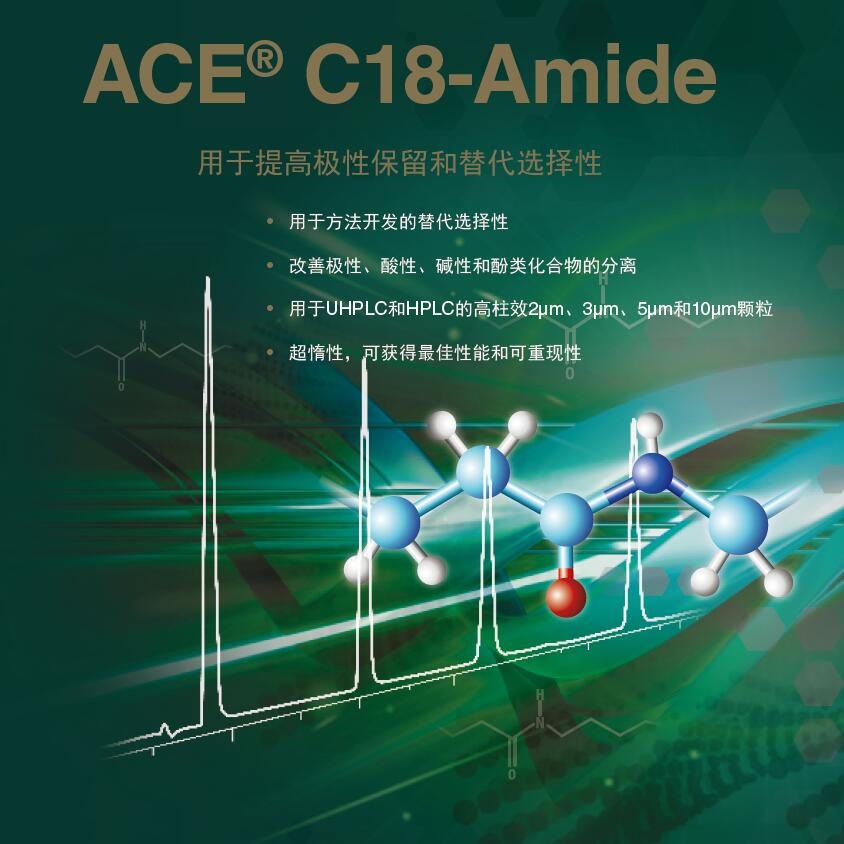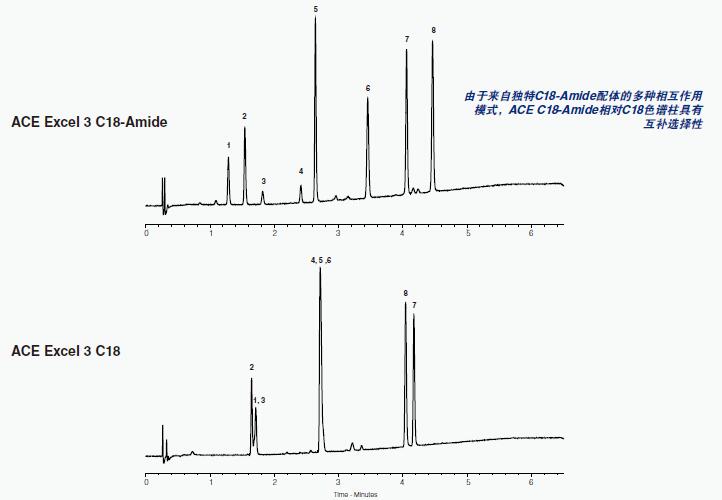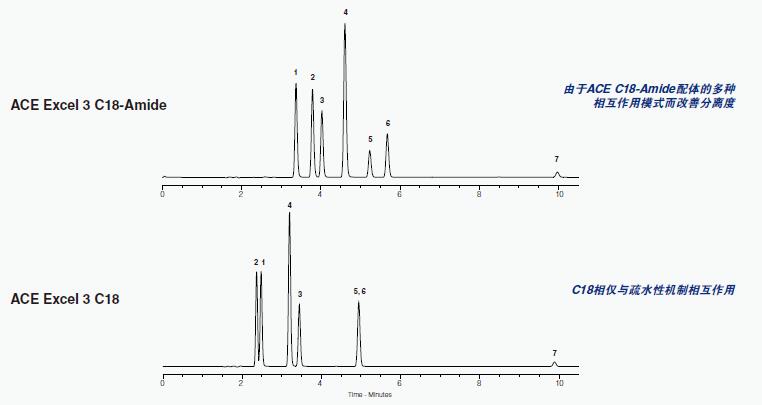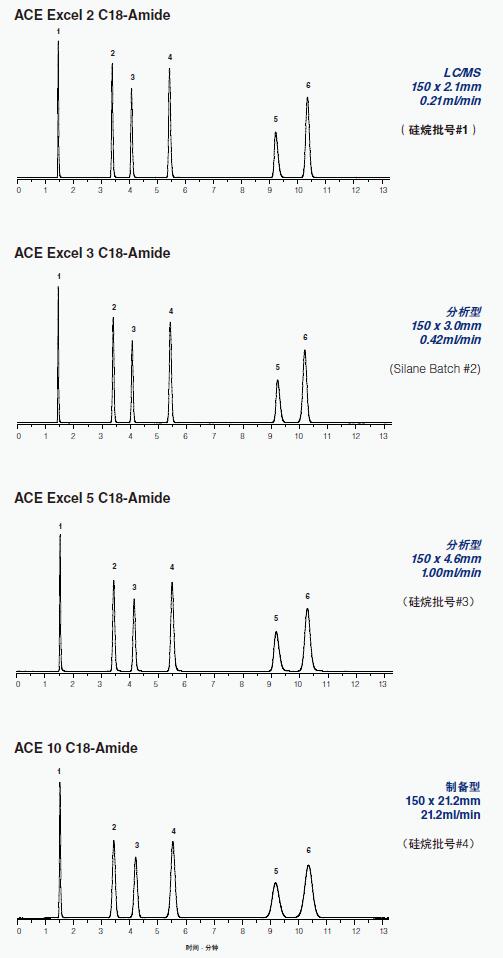Improves the separation of polar, acidic, basic and phenolic compounds - ACE C18-Amide column
Small Food Product Series,Egg And Milk Flour Products,Crispy Cones With Crisp And Rich Flavor,Red Bean Paste Filled Cone Tianjin Yongkang Food Co., Ltd , https://www.yongkangfood.com
• Alternative selectivity for method development • Improves separation of polar, acidic, basic and phenolic compounds • High column efficiency 2μm, 3μm, 5μm and 10μm particles for UHPLC and HPLC • Ultra inert for optimum performance and Reproducibility 
ACE C18-Amide LC column
Used to improve polarity retention and substitution selectivity
Ideal column selection for method development ■Relative C18 and C8 columns with alternative selectivity for polar molecules - especially acids ■Compatible with 100% water content mobile phase ■For UHPLC, HPLC and preparative separation High column efficiency 2μm, 3μm, 5μm and 10μm particles ■Low loss of UV and LC/MS compatibility 
Recommended Applications â– Small molecule water-soluble analytes and polar compounds â– H-bond donors, acids, bases and phenolic compounds â– Small molecule peptides
Why does the ACE C18-Amide LC column provide an alternative selectivity?
â– ACE C18-Amide combines C18 with polar amide groups on a single ligand â– Extended spacer technology can extend column life 
Using ACE C18-Amide HPLC column chromatography ability to selectively separate <br> peak resolution equation may determine parameters that affect the degree of separation: N, α and k. In recent years,
Emphasis is placed on the use of ultra-efficient “UHPLC†columns (such as the ACE Excel 2μm column) as a means of achieving separation targets. 
However, selectivity is often overlooked.
Among the three parameters affecting the resolution, selectivity is the most important (see Figure 1).
Better and faster separation is usually achieved by utilizing efficiency and selectivity.
The ACE C18-Amide LC column is the latest addition to the ACE series of bonded phases, offering complementary selectivity and particle size options of 2μm, 3μm, 5μm and 10μm to develop robust UHPLC and HPLC methods.
Figure 1. Effect of N, α, and k on resolution (Rs) for typical separations of N = 10,000, k = 4, and α = 1.1 
Increasing N, α, or k can increase the resolution (Rs), but as you can see from the above graph, an increase in N or k will quickly reduce the rate of return. Increasing the selectivity (α) does not cause this problem, so it is the most important optimization parameter among the three variables when developing the separation method.
Separating chromatographic peaks using the stationary phase selectivity of the ACE bonded phase <br> Figure 2 illustrates the difference between the two ACE bonded phases, C18-Amide and C18.
Although both of these bonding phases provide the potential for strong hydrophobic interaction from their respective C18 chains, the amide group embedded in the C18-Amide phase introduces additional modes of interaction, ultimately increasing the retention of polar compounds and providing an alternative. Selectivity. 
Samples: 1) resorcinol 2) catechol 3) 2-methyl resorcinol 4) 4-methyl catechol 5) 3-methyl catechol 6) 4-nitro-ortho Hydroquinone mobile phase: 25:75 acetonitrile / 27 mM H3PO4 (dissolved in water)
Column size: 150 x 4.6mm
Flow rate: 1.50ml/min
Temperature: 30 ° C
Wavelength: 270nm
ACE C18-Amiede LC column for enhanced polarity selectivity
Comparison of ACE C18-Amide with leading C18 UHPLC columns 
Column size: 50 x 2.1mm
Samples: 1) resorcinol 2) catechol 3) 2-methyl resorcinol 4) 4-methyl catechol 5) 3-methyl catechol 6) 4-nitro-ortho Hydroquinone mobile phase: 25:75 methanol / 25 mM H3PO4 (dissolved in water)
Flow rate: 0.30ml/min
Temperature: 30 ° C
Wavelength: 214nm
Comparing data does not represent all applications.
Method development using alternative selectivity <br> Separation of acidic, basic and neutral compounds 
Samples: 1) methylphenyl sulfoxide 2) guanolol 3) 3-hydroxybenzoic acid 4) 1,2-dimethoxybenzene 5) berberine 6) myricetin 7) piperine 8) poplar Mobile phase: A = 20 mM ammonium formate (dissolved in water) (pH 3.0) B = 20 mM ammonium formate (pH 3.0) (dissolved in 90:10 (v/v) methanol / water)
Gradient: 3 – 100% B in 5 minutes B
Column size: 50 x 2.1mm
Flow rate: 0.60ml/min
Temperature: 40 ° C
Wavelength: 254nm
Compatible with mobile phase with 100% water content <br> Separation of organic acids in wine 
Samples: 1) oxalic acid 2) tartaric acid 3) malic acid 4) lactic acid 5) ascorbic acid 6) citric acid mobile phase: 40 mM NH4H2PO4 (dissolved in water) (pH 2.5)
Column: ACE Excel 3 C18-Amide, 250 x 2.1mm
Flow rate: 0.21ml/min
Temperature: 25 ° C
Wavelength: 214nm
ACE C18-Amide offers alternatives <br> Food & Beverage Additives - Vanillin 
Samples: 1) vanillic acid 2) 4-hydroxybenzoic acid 3) vanillin 4) 4-hydroxybenzaldehyde 5) guaiacol 6) ethyl vanillin 7) eugenol mobile phase: A = 0.1% formic acid (dissolved) In water) B = 0.1% formic acid (in acetonitrile)
Gradient: 30 – 55% B in 10 minutes B
Column size: 150 x 4.6mm
Flow rate: 1.00ml/min
Temperature: 40 ° C
Wavelength: 260nm
Steroid 
Samples: 1) prednisone 2) prednisolone 3) estriol 4) corticosterone 5) 11a-hydroxyprogesterone 6) 11-ketoprogesterone 7) 21-hydroxyprogesterone 8) β-estradiol 9) 17α-estradiol 10) 17α-ethynyl estradiol mobile phase: A = 0.1% formic acid (dissolved in water) B = 0.1% formic acid (dissolved in acetonitrile)
Gradient: 25 – 80% B in 10 minutes B
Column size: 50 x 2.1mm
Flow rate: 0.40ml/min
Temperature: 25 ° C
Wavelength: 260nm
Guaranteed reproducibility and full scalability
Reproducibility extension of ACE C18-Amide 
Samples: 1) uracil 2) 4-hydroxybenzoic acid 3) acetylsalicylic acid 4) benzoic acid 5) 2-hydroxybenzoic acid 6) ethyl p-hydroxybenzoate mobile phase: 35:65 acetonitrile / 0.1% TFA ( Dissolved in water)
Temperature: 22 ° C
Wavelength: 254nm
Combining the available particle sizes of 2 μm, 3 μm, 5 μm and 10 μm with a series of column sizes from UHPLC to preparative HPLC scale ensures that the method can be reproducibly scaled up or down.
The chromatogram in Figure 8 shows excellent reproducibility when the silica gel batch and silane batch are changed, and reproducible scalability is obtained when the particle size and column diameter are changed.
Product availability and specifications phase Functional group End cap Particle size (μm) Aperture (Å) Surface area (m2/g) Carbon load Maximum pH range 100% water compatible USP list ACE C18-Amide Octadecyl group with intact amide polar group Yes 2, 3, 5, 10 100 300 16.4 2.0-8.0 a Yes L1/L60
For optimum column life, a pH range of 2-8 is recommended. In order to increase column lifetime at higher pH values, organic buffers, low buffer concentrations, high % organic solvents, and low temperatures must be considered.
To further extend column life under HPLC conditions (up to 5000 psi / 350 bar), it is recommended to use an ACE guard column or an ACE HPLC pre-column filter.
To further extend column life under UHPLC conditions (up to 15,000 psi / 1000 bar), an ACE UHPLC pre-column filter is recommended.
For HPLC column connectors up to 5000 psi (350 bar), PEEK hand tight fittings (p/n ACE-CC10) are recommended.
Reusable connectors (p/n EXL-CC10) are recommended for UHPLC column connectors up to 15,000 psi (1000 bar).
ACE® is a registered trademark of Advanced Chromatography Technologies Limited. ACE ExcelTM is a trademark of Advanced Chromatography Technologies Limited. Advanced Chromatography Technologies Limited recognizes registered and unregistered trademarks of Agilent Technologies Inc., Phenomenex Inc., Thermo Fisher Scientific, and Waters Corporation, and has no affiliation with these companies.